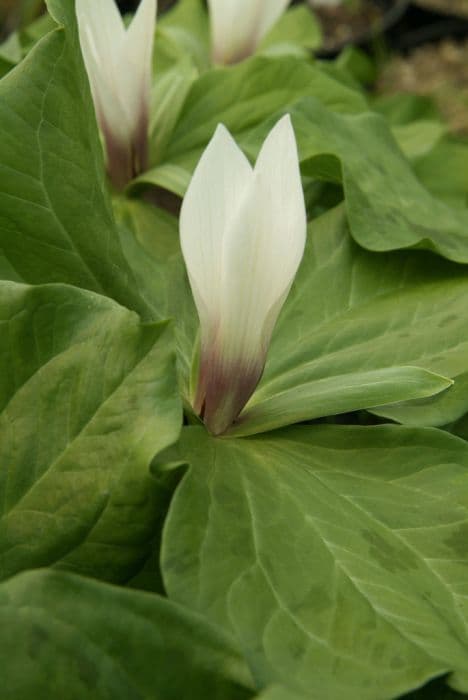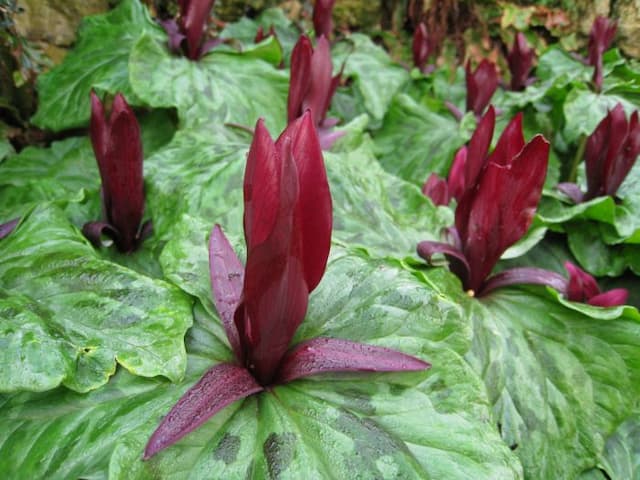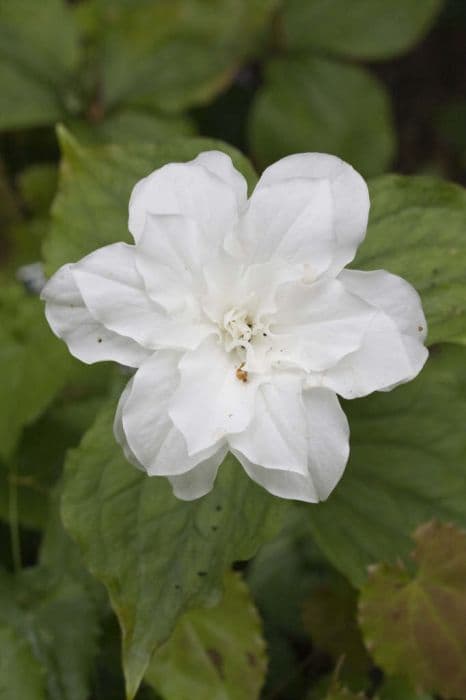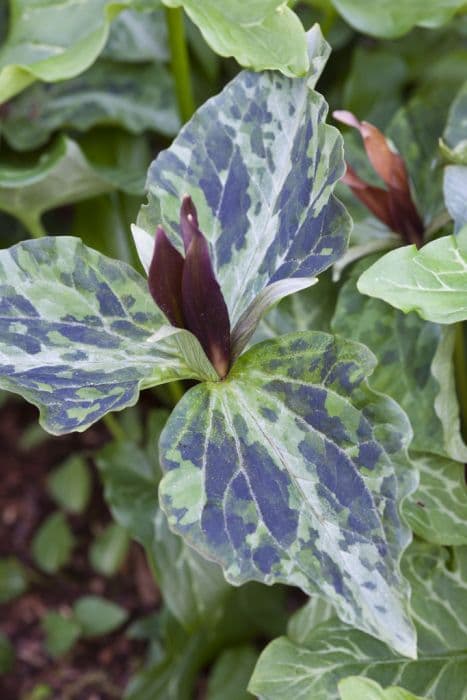White trillium Trillium grandiflorum f. roseum

ABOUT
The plant known as the rosy trillium boasts a striking appearance with three large, rounded leaves that sit directly at the base from which a single erect stem arises. Atop this stem sits a single, showy flower. The flower is distinguished by three diamond-shaped petals that are soft pink to rose in color, creating a delicate and attractive look. The petals surround a set of six stamens and a trio of dark green, almost ovate-shaped sepals which contrast the pink petals. The center of the flower is a prominent, ovary that is also a deep green, completing the charming appearance of the rosy trillium. This variety is particularly noted for its pink petals, as other members of its species typically have white flowers. It blooms in the springtime, adding a splash of color to woodland settings where it naturally occurs.
About this plant
 Names
NamesFamily
Melanthiaceae
Synonyms
Pink Trillium, Rose Trillium, Large-Flower Trillium, Great White Trillium
Common names
Trillium grandiflorum f. roseum.
 Toxicity
ToxicityTo humans
White trillium, as Trillium grandiflorum f. roseum is commonly known, is not considered highly toxic to humans, but it can cause mild gastrointestinal upset if ingested. While serious poisoning is rare, ingestion of any part of the plant may result in symptoms such as nausea, vomiting, and diarrhea. If any parts of the plant are consumed, medical attention should be sought to manage the symptoms.
To pets
White trillium is also not highly toxic to pets, but it can still cause mild discomfort if ingested. Similar to humans, if a pet consumes any part of the white trillium, it may experience symptoms like vomiting, drooling, or diarrhea. These symptoms are usually mild, but if your pet has consumed white trillium and is showing signs of distress, it is advisable to contact a veterinarian.
 Characteristics
CharacteristicsLife cycle
Perennials
Foliage type
Deciduous
Color of leaves
Green
Flower color
Pink
Height
1-2 feet (30-60 cm)
Spread
1-2 feet (30-60 cm)
Plant type
Herb
Hardiness zones
4-9
Native area
North America
Benefits
 General Benefits
General Benefits- Ecosystem Support: Serves as an early spring food source for pollinators such as bees and butterflies.
- Habitat Enrichment: Provides cover and nesting opportunities for small wildlife.
- Biodiversity: Contributes to forest diversity, supporting a range of flora and fauna.
- Soil Stabilization: Helps prevent soil erosion in woodland areas with its root system.
- Landscape Aesthetics: Offers ornamental value with its distinctive three-petaled flowers and lush foliage.
- Native Plant Conservation: Cultivating this native species can help preserve local plant communities.
- Educational Value: Can be used to educate people about native plant species and the importance of woodland conservation.
- Seasonal Interest: Adds visual interest to gardens and natural areas in the springtime.
 Medical Properties
Medical PropertiesThis plant is not used for medical purposes.
 Air-purifying Qualities
Air-purifying QualitiesThis plant is not specifically known for air purifying qualities.
 Other Uses
Other Uses- Garden Ornamentation: Trillium grandiflorum, commonly known as White Trillium, is often used in shade gardens for its striking white blooms which can provide a dramatic contrast against the darker foliage of woodland settings.
- Educational Tool: White Trillium can be used in botany and ecology education as an example of a spring ephemeral plant and as a tool to demonstrate plant reproductive strategies and pollen vectors.
- Photography Subject: Due to its beauty, White Trillium is a popular subject for photographers, particularly nature and macro photography enthusiasts.
- Native Plant Conservation: White Trillium is used in native plant conservation efforts to restore natural habitats and maintain biodiversity.
- Indicator of Forest Health: White Trillium is considered an indicator species, signifying the health of a forest ecosystem and the presence of certain soil conditions.
- Cultural Symbol: In some regions, the White Trillium is used as a cultural symbol, representing various local values and included in artwork, flags, and symbols.
- Bee Forage: Although not widespread knowledge, White Trillium flowers can provide early spring nectar and pollen for foraging bees and other pollinators.
- Erosion Control: When planted in large groups, White Trillium can help stabilize soil and prevent erosion in sloped woodland gardens or natural areas.
- Gift Plant: Due to its beautiful and distinctive three-petal flowers, White Trillium is given as a gift, representing elegance and beauty in a natural, unaltered form.
- Symbol of Truce: In certain customs, White Trillium can be used as a symbol of truce or peace due to its pure and striking appearance.
Interesting Facts
 Feng Shui
Feng ShuiThe plant Trillium is not used in Feng Shui practice.
 Zodiac Sign Compitability
Zodiac Sign CompitabilityThe plant Trillium is not used in astrology practice.
 Plant Symbolism
Plant Symbolism- Elegance and Beauty: The Trillium grandiflorum f. roseum, also known as the Pink Trillium, is often associated with elegance and beauty due to its striking three-petaled floral display.
- Purity and Innocence: With its traditional white coloration (the pink form being a less common variation), trilliums are frequently symbolic of purity and innocence.
- Rebirth and Recovery: As a plant that emerges in the spring, Pink Trillium is often seen as a symbol of rebirth and the recovery of nature after the winter.
- Trinity: The trillium's characteristic three-petaled flowers and leaf arrangement can symbolize concepts of trinity, which in various religions include aspects such as body, mind, and spirit or father, son, and holy spirit.
 Water
WaterThe Painted Trillium should be watered deeply and thoroughly when the soil feels dry to the touch, usually every week or two, depending on weather conditions and soil drainage. Watering should be done at the base of the plant using enough water to soak the soil around the roots, which can be approximately 1-2 gallons for established plants. During hot or dry spells, increase the frequency of watering to prevent the soil from drying out completely. Over-watering or allowing the plant to sit in waterlogged soil should be avoided to prevent root rot.
 Light
LightPainted Trillium thrives in dappled sunlight or partial shade, mimicking its natural woodland habitat. The ideal spot for this plant would be under the canopy of deciduous trees where it receives filtered light throughout the day. Too much direct sunlight can scorch the leaves, while too little can hinder flowering, so finding that balance is key for the plant's health.
 Temperature
TemperaturePainted Trillium grows best in temperatures that mimic its native woodland conditions, typically between 60°F and 75°F, but can survive in temperatures as low as 20°F and as high as 85°F. However, it is important to protect the plant from extreme heat and provide mulch to keep the root zone cooler during hot spells.
 Pruning
PruningPruning of Painted Trillium is generally not necessary apart from removing dead or damaged foliage to maintain plant health. Pruning should be done after the plant flowers and foliage has yellowed and died back, usually in late summer or autumn. This cleanup helps prevent disease and may encourage better growth in the following season.
 Cleaning
CleaningAs needed
 Soil
SoilThe Painted Trillium prefers slightly acidic soil with a pH of 5.5 to 6.5. For the best results, mix well-draining soil with compost and leaf mold to mimic the plant's natural woodland conditions.
 Repotting
RepottingPainted Trilliums rarely need repotting as they are slow growers and prefer undisturbed roots; repot only if necessary every 3-4 years.
 Humidity & Misting
Humidity & MistingPainted Trillium thrives in moderate humidity levels, mimicking its natural forest habitat; aim for a humidity range of 40-60%.
 Suitable locations
Suitable locationsIndoor
Provide shade, cool temps, and moist, rich soil.
Outdoor
Plant in dappled shade, moist soil, spring only.
Hardiness zone
4-7 USDA
 Life cycle
Life cycleTrillium grandiflorum f. roseum, commonly known as the Pink Large-flowered Trillium, starts its life as a seed, often dispersed by ants through myrmecochory, which then germinates and develops a rhizome. The plant grows a single shoot that emerges from the ground in early spring, typically unfurling three distinctive leaves in a whorl. Following leaf development, the plant produces a singular, attractive three-petaled pink flower atop its stem, which is pollinated by various insects, primarily bees. After pollination, the flower develops into a berry-like fruit containing seeds that mature and are subsequently dispersed. The plant then goes into a state of dormancy during the winter months, when the above-ground parts die back, and it survives underground as a rhizome. Each year, the cycle repeats with the rhizome sending up new shoots in the spring.
 Propogation
PropogationPropogation time
Spring-Early Summer
The most popular method of propagation for Trillium grandiflorum f. roseum, commonly known as the pink trillium, is by seed. Sowing seeds should ideally be done in the fall immediately after collection as they require a period of cold stratification to break dormancy—a process that mimics the natural cycles of warm and cold periods they would experience in the wild. Plant the seeds about a half-inch (approximately 1.3 centimeters) deep in a moist, well-draining soil mix. Position the container in a shaded area and maintain consistent moisture. Germination can be slow, sometimes taking a couple of years, and once the seedlings emerge, they should be allowed to grow in their pots for at least a couple of seasons before being transplanted into the garden. This ensures that the young plants are robust enough to compete with other plants and the various environmental factors they will face outdoors.








